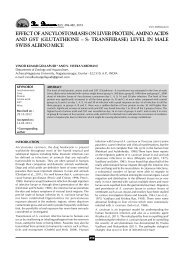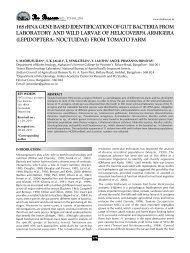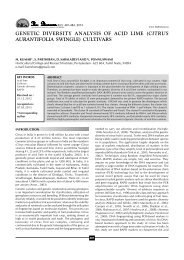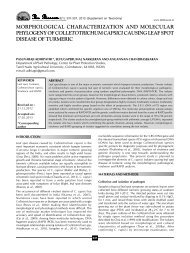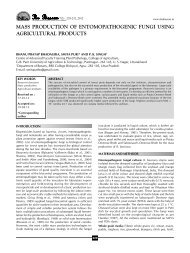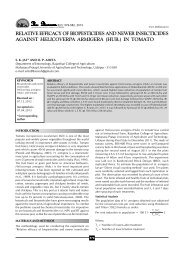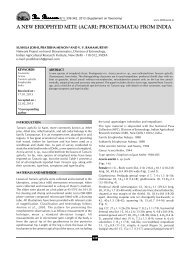NSave Nature to Survive - THE BIOSCAN
NSave Nature to Survive - THE BIOSCAN
NSave Nature to Survive - THE BIOSCAN
Create successful ePaper yourself
Turn your PDF publications into a flip-book with our unique Google optimized e-Paper software.
JOGEN CH. KALITA et al.,<br />
Table 3: Density and diversity of phy<strong>to</strong>plank<strong>to</strong>n in Koya Kujiya,<br />
Abhayapuri, Assam<br />
Types and species Density per liter Remarks<br />
Myxophyceae Total number 6561<br />
Nos<strong>to</strong>c linckia 3043 (48.82% of the <strong>to</strong>tal<br />
phy<strong>to</strong>plank<strong>to</strong>n / litre)<br />
Anabaena sp. 938<br />
Microcystis sp. 2580<br />
Chlorophyceae Total number 6794<br />
Volvox aureus 4052 (50.55% of the <strong>to</strong>tal<br />
phy<strong>to</strong>plank<strong>to</strong>n / litre)<br />
Eudorina elegans 1485<br />
Spirogyra spiralis 7<br />
Ulothrix zonata 1150 Total number 85<br />
Bacillariophyceae (0.63% of the <strong>to</strong>tal<br />
phy<strong>to</strong>plank<strong>to</strong>n / litre)<br />
Tabellaria fenestrata 23<br />
Pinnularia sp. 8<br />
Dia<strong>to</strong>ma sp. 17<br />
Asterionella formusa 6<br />
Melosera 31<br />
Total 13,440<br />
of FCO 2 was resulted by the presence of varieties of aquatic<br />
weeds, which were responsible for increase of FCO 2 beel<br />
concentration during early morning and night, while depletion<br />
resulted during day time.<br />
Total alkalinity<br />
Total alkalinity plays an important role in fresh water ecology.<br />
The average value of <strong>to</strong>tal alkalinity of the beel water was<br />
recorded 37.6 mg L -1 . However, the range of TA in the studied<br />
beel was recorded from 34.0 mg L -1 <strong>to</strong> 95.0 mg L -1 (Table 1).<br />
Total hardness<br />
Total hardness is the indica<strong>to</strong>r of <strong>to</strong>tal calcium and magnesium<br />
salts present in water. It plays a significant role in the<br />
productivity of fresh water habitat. The <strong>to</strong>tal hardness in water<br />
of the studied beel was recorded from 25.0 mg L -1 <strong>to</strong>140 mg L -<br />
1 with a mean value of 35.0 mg L -1 (Table 1).<br />
Calcium and magnesium concentration<br />
The calcium and magnesium content in freshwater is also an<br />
important fac<strong>to</strong>r for maintaining productivity of water.<br />
Dissolved calcium concentrations in water of the studied beel<br />
was recorded from 9.0 mg L -1 <strong>to</strong> 26.0 mg L -1 with a mean value<br />
of 15.0 mg L -1 . The present findings indicate that the water of<br />
the beel contains available calcium, which maintain the<br />
alkalinity of the water body. Similarly, the average value of<br />
magnesium concentration was 12.0 mg L -1 with a range<br />
recorded from 7.0 mg L -1 <strong>to</strong> 18.0 mg L -1 (Table 1).<br />
Dissolved organic matter<br />
The dissolved organic matter of water indicates some <strong>to</strong>tal of<br />
the organic substances dissolve in it in the form of different<br />
soluble substances. The dissolved organic matter in water of<br />
Koya Kujiya Beel was recorded from minimum of 2.26 mg L -1<br />
<strong>to</strong> maximum of 5.68 mg L -1 with a mean value of 3.45 mg L -1<br />
(Table 1). The fluctuation of DOM in the studied beel exhibits<br />
a very good productive condition of the water body and<br />
suitable for aquaculture. High concentration of dissolved<br />
organic matter implies presence of high nutritive organic matter<br />
for fishes, which supports fast growth of several fish species.<br />
428<br />
Plank<strong>to</strong>n diversity in the beel<br />
Zooplank<strong>to</strong>n<br />
The diversity and density (number L -1 ) of zooplank<strong>to</strong>n were<br />
recorded during the period from May, 2007 <strong>to</strong> August, 2007<br />
in different location and depth of the studied beel. Four major<br />
groups of zooplank<strong>to</strong>n have been recorded in the beel, which<br />
exhibited average density of 244 numbers L -1 (Table 2). Thirty<br />
one species and twenty five (25) genera of zooplank<strong>to</strong>n<br />
belonging <strong>to</strong> four classes namely Pro<strong>to</strong>zoa, Rotifera, Copepoda<br />
and Cladocera were identified with varying densities. The<br />
order of average density of zooplank<strong>to</strong>n in the beel were<br />
recorded as Copepods (31.6 %) > Cladocera (24.7 %) ><br />
Pro<strong>to</strong>zoa (22.9 %) > Rotifera (20.8 %) (Table 2).<br />
Among the eight different species of Pro<strong>to</strong>zoan, Euglena and<br />
Phacus were recorded as dominant, while the Chilomonus<br />
and Chlamidomonas showed very low density. Among the<br />
Rotifers, Brachionus and Lecane sp. were recorded as<br />
dominant and Rotaria and Asplanchna sp. were in low density<br />
in the beel. Similarly, Daphnia and Artemia sp. belonging <strong>to</strong><br />
Cladocera and Eucyclopes and Phylodiap<strong>to</strong>mus belonging<br />
<strong>to</strong> Copepodes were found as dominant zooplank<strong>to</strong>n in the<br />
studied beel. On the other hand, the genus Macrothrix, Moina<br />
and Alona of Cadocera and the genus Tropodiap<strong>to</strong>mus and<br />
Neodiap<strong>to</strong>mus belonging <strong>to</strong> Copepodes were recorded with<br />
low density in the beel during the study period.<br />
Phy<strong>to</strong>plank<strong>to</strong>n<br />
Phy<strong>to</strong>plank<strong>to</strong>n diversity in the beel was also very rich. During<br />
the study period (summer season) there were 13,440 number<br />
per litre phy<strong>to</strong>plank<strong>to</strong>n was recorded, of which 50.55%<br />
Chlorophyceae, 48.82% Myxiphyceae and only 0.63%<br />
Bacillariophyceae. Al<strong>to</strong>gether 12 different species of<br />
phy<strong>to</strong>plank<strong>to</strong>n were recorded during the study period in the<br />
beel (Table 3). Chlorophyceae and Myxophyceae was the<br />
major constituent of phy<strong>to</strong>plank<strong>to</strong>n which indicated suitability<br />
of the water body of the beel for aquaculture.<br />
Fish resources of Koya Kujiya Beel<br />
Fish diversity of Koya Kujiya Beel has been recorded after the<br />
physical verification and interview with the local fishermen of<br />
the beel. Fish specimens are collected from the fishermen and<br />
the lessee of the beel and were identified on spot and in<br />
labora<strong>to</strong>ry by following standard methodologies (Talwar and<br />
Jhingran, 1991; Vishwanath, 2002). There were 45 species of<br />
fishes recorded in the beel during the study period. All <strong>to</strong>gether<br />
45 fish species were known <strong>to</strong> occur in the beel and their<br />
status was determined after field study and interviewing the<br />
fishermen and the lessee of the studied beel area. The Table 4<br />
shows the fish resources of the beel. Among the species<br />
identified in the present study, 10 species under major group,<br />
13 species under intermediate group and 22 species were<br />
under minor group on the basis of their size at matured stage.<br />
Major group<br />
There were 10 fish species recorded in the beel during the<br />
study period which were included as major group (Table 4).<br />
Among these fishes Catla catla, Labeo rohita, Labeo gonius,<br />
Cirrhinus mrigala were found as major constituent, but their<br />
quantities were in decreasing in order. The fish species like<br />
Labeo calbasu, Channa striatus, Aorichthys seenghala had



